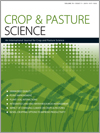Echinochloa species are highly problematic summer weeds causing significant losses to growers throughout Australian cropping regions. We review the current information available on the biology, ecology and management of these species, identify knowledge gaps, and prioritise future research opportunities. Cultural practices developed based on a better understanding of biology and ecology of Echinochloa species, combined strategically with herbicides, would likely provide sustainable control across northern grains regions of Australia.

Crop and Pasture Science
Volume 70 Number 11 2019
CP19155Potential impact of elevated atmospheric carbon dioxide and climate change on Victorian wheat marketing grades and value
 , Patrick Wilson, Brian Kearns, Glenn J. Fitzgerald, Joe F. Panozzo, Cassandra K. Walker, Brendan Christy, James G. Nuttall, Roger D. Armstrong
, Patrick Wilson, Brian Kearns, Glenn J. Fitzgerald, Joe F. Panozzo, Cassandra K. Walker, Brendan Christy, James G. Nuttall, Roger D. Armstrong  , Michael Tausz and Garry J. O' Leary
, Michael Tausz and Garry J. O' Leary
Increasing atmospheric carbon dioxide and climate changes are expected to affect future wheat yields and quality. The impact of these changes by 2050 were predicted for different Victorian regions compared with historical production, the Mallee region being most affected with a 43% reduction in yield and 43% of grain being downgraded owing to reduced grain protein. With present price premiums for grain quality, the reductions in grain protein had little impact on wheat value compared with the predicted changes in yield.
Wheat stripe rust is one of the most damaging diseases in common wheat globally. We characterised a stripe rust resistance gene and identified several markers associated with YrH922 in wheat line H922-9-12. YrH922 and the linked marker can be easily used in marker-assisted selection breeding.
Rice production in south-eastern Australia has been affected by irregular water supply, and alternative regions in the north have been proposed to fill this production shortfall. Rice grain quality from new growing areas must match or exceed current consumer expectations for Australian rice, and this study delivers information on quality for both commercial and parental rice varieties. Rice breeders, marketers and agronomists can utilise this information to build strategies to create a sustainable rice industry.
CP19257Soil and weather conditions associated with plant damage from post-emergent metribuzin in lentil (Lens culinaris) in southern Australia
Lentil is a pulse crop of expanding importance in Australia, but production is limited by weed competition and a lack of safe and effective herbicides. Metribuzin is a broad-spectrum herbicide used in lentil; however, multiple soil and weather conditions exacerbated plant damage, particularly heavy-rainfall events within 10 days of post-emergent application on light-textured soils low in soil moisture. This research highlights the need for the development of lentil cultivars with a higher level of tolerance to metribuzin under Australian conditions.
Alternaria brassicae is a widely recognised as a significant pathogen of oilseed brassicas, especially canola and mustard, infesting all plant components and causing adverse yield loss, whereas A. japonica is newly recognised but little understood. Disease epidemic development and yield impacts of the two species were compared, and the findings explained why Alternaria leaf spot epidemics accelerate during the growing season as foliage becomes more susceptible with age and as more susceptible, later developing leaves become abundant. This provides critical information for A. japonica in relation to timing of symptom appearance, susceptibility of different foliage components, disease progression, and associated severe yield loss.
CP19130Absorption of cadmium accompanied by EDTA varies according to tomato cultivar
Ethylenediamine tetraacetic acid (EDTA) is often used as extraction accelerator for phytoremediation of contaminated soil, but how does that happen? Two tomato varieties (high- and low-accumulator) showed higher uptake rate for Cd ion than Cd-EDTA, accompanied by different expression patterns of transporter genes related to Cd absorption, which proved their roles as transporters in the phytoremediation process promoted by EDTA and their differences among genotypes. Our results will provide useful information for phytoextraction or improvements in plant tolerance to Cd toxicity.
CP19264Amending sugarcane monoculture through rotation breaks and fungicides: effects on soil chemical and microbial properties, and sucrose yields
 , Hardev S. Sandhu, James M. McCray, Richard N. Raid, John E. Erickson and Andrew V. Ogram
, Hardev S. Sandhu, James M. McCray, Richard N. Raid, John E. Erickson and Andrew V. Ogram
Introduction of cowpea or soybean rotations in sugarcane cultivation on Histosols lowered soil C : N ratios, fungal biomass and fungi : bacteria ratios and improved sugarcane yields compared with sweet corn rotation or bare fallow. Seed-cane treatments with mancozeb, mefenoxam or azoxystrobin fungicides significantly improved sugarcane yields compared with the untreated check in plant crop but had no yield advantage in first ratoon crop. This field study helps sugarcane growers to practice leguminous rotation breaks during the fallow period and seed-cane fungicidal treatments for achieving higher yields.
CP18530The clonal grass Leymus chinensis overcomes salt stress by over-compensatory growth of individual ramets
Soil salinisation and overgrazing are two important factors limiting plant growth in the Songnen Grassland, China; how the dominant species Leymus chinensis resists the dual effect of these stresses remains largely unknown. Our results highlight the importance of rhizome soluble sugar during clipping and saline–alkali tolerance. This study provides a theoretical basis for promoting the restoration of L. chinensis grassland under the combined clipping and saline–alkali stresses.
CP19078Variation in root morphology and P acquisition efficiency among Trifolium subterraneum genotypes
 , Rebecca E. Haling, Richard J. Simpson
, Rebecca E. Haling, Richard J. Simpson  , Xiaoxi Li, Richard J. Flavel and Chris N. Guppy
, Xiaoxi Li, Richard J. Flavel and Chris N. Guppy
Trifolium subterraneum L. (subterranean clover) is the most widely grown annual pasture legume in southern Australia and requires frequent applications of phosphorus (P) fertiliser to maintain high productivity. Twenty-six genotypes of this legume were grown in a P-deficient soil to assess parameters of yield, root morphology and P acquisition. The results demonstrate significant variation among genotypes for P acquisition and shoot yield in low P soil. The differences were primarily attributed to variation in nutrient-foraging root length.



